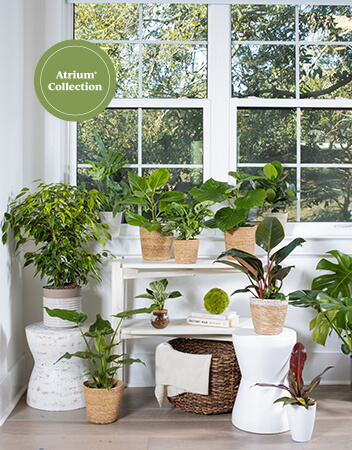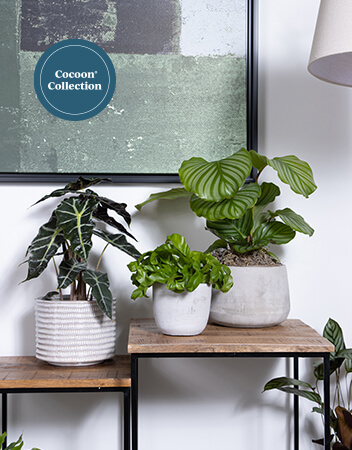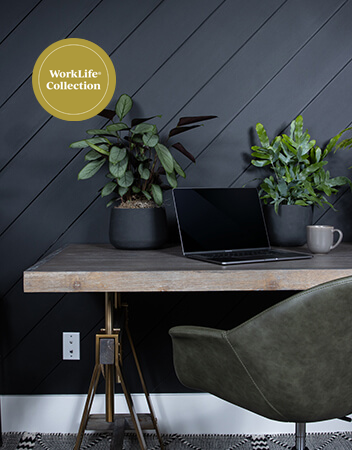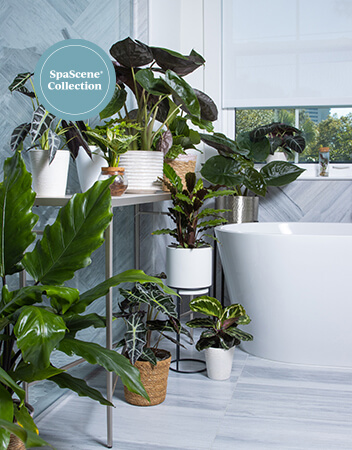Fertilizing Houseplants - A Proven Winners Guide
Learn how to fertilize indoor plants for a lush, beautiful appearance
 Check here to see if your Local Garden Center or The Home Depot® is carrying leafjoy®.
Check here to see if your Local Garden Center or The Home Depot® is carrying leafjoy®.
Like humans and animals, plants require a balanced diet with the proper nutrients in order to be healthy and thrive. Basic plant needs include light, water, and nutrients. Indoor houseplants, which are grown in an environment different than their native habitat, benefit from a regular boost of nutrients during the growing season in order to look and perform their best.
Plant fertilizers contain essential nutrients of nitrogen, phosphorus and potassium, as well as micronutrients that give plants a balanced diet for healthy growth. There are many different types of indoor plant fertilizers that will encourage lush, beautiful foliage and vigorous growth. Here’s how to choose and use fertilizer for your indoor houseplants.
Plant Fertilizer Basics
There are three essential nutrients that plants need. These are known as primary or macronutrients. Nitrogen (N) helps plants to produce lush new growth and healthy foliage that plants need to convert sunlight into food. Phosphorus (P) promotes developing flowers, fruit and a healthy root system. Potassium (K) affects overall growth, helping plants to be more resistant to pests and diseases.
Related: 15 Easy Indoor Plants for Beginners
The percentage of macronutrients (N-P-K) contained in fertilizers is listed on fertilizer packaging. Fertilizers with numbers such as 4-4-4 or 10-10-10 are considered “balanced,” with equal amounts of nutrients. Other fertilizers have varying proportions of nutrients to suit different plant needs. Nutritional requirements for houseplants differ from other plants such as trees, flowering annuals, or tomatoes.
Indoor houseplants grown primarily for the foliage will benefit from a fertilizer higher in nitrogen, while flowering plants such as peace lily, African violets and orchids will perform best with a fertilizer higher in phosphorus that will promote flowering.
There are also micronutrients that plants need in order to thrive. These include boron, copper, iron, manganese and zinc. Natural and pre-packaged fertilizers will contain both macro- and micronutrients. Too much or too few nutrients, or nutrients in the wrong proportions, can result in health problems for plants. These can include:
- Weak, stunted, or deformed growth
- Yellow or dropped leaves
- Fertilizer burn, which can damage or kill plants
Types of Houseplant Fertilizers
Plant fertilizers can be organic or synthetic. Organic fertilizers such as fish emulsion or seaweed help to improve soil health over time, while synthetic fertilizers have no added benefit to soil health.
There are three basic types of fertilizer for indoor plants:
 Slow-release fertilizers are pellets, granules or spikes that release a small amount of fertilizer into the soil every time plants are watered. These break down slowly over a period of weeks or months, delivering a steady supply of nutrients to plants. Time-release fertilizer needs to be replenished less often.
Slow-release fertilizers are pellets, granules or spikes that release a small amount of fertilizer into the soil every time plants are watered. These break down slowly over a period of weeks or months, delivering a steady supply of nutrients to plants. Time-release fertilizer needs to be replenished less often.
Water-soluble fertilizers come in a dry powder form. They are mixed in water and applied to the soil. These fertilizers need to be reapplied more frequently.
Liquid fertilizers are either ready-to-use or concentrates that are diluted in water. They can be applied directly to the soil or sprayed onto plant foliage. Nutrients are delivered more directly, allowing plants to absorb them more quickly. Liquid fertilizer does not last as long and needs to be replenished more often, generally once or twice a month.
When buying fertilizer, make sure packaging specifies use for houseplants. The best fertilizer for indoor plant varieties depends on the type of plant. While there are many different all-purpose houseplant fertilizers, there are also specialized formulations for flowering houseplants, cacti and succulents.
How to Fertilize Indoor Plants
Because most houseplants are watered regularly, soil nutrients will become depleted. This requires re-application of fertilizers while plants are actively growing. Most common houseplants are leafy tropicals that can be fertilized on the same schedule with a high-quality, all-purpose formulation.
Newly purchased houseplants are potted in fresh soil that contains fertilizer. Over time, nutrients for indoor plants leach out of the potting soil and need to be replenished. Plants potted in fresh soil won’t need supplemental fertilizing until 1 to 2 months after planting.
Follow these fertilizing tips:
- When fertilizing indoor plants, follow instructions on the fertilizer label.
- Begin fertilizing in March when days are lengthening and houseplants begin to show new growth.
- Morning is the best time to feed plants. This allows for better absorption before the heat of the day.
- Water potted plants in between fertilizer applications to avoid a buildup of salt and other minerals.
- Make sure containers have adequate drainage holes in the bottom to allow excess water to drain through.
- In late summer to early fall, gradually taper off the frequency and strength of fertilizing as plant growth slows down.
- Cease fertilizing during late fall and winter months when plants are semi-dormant.
Common Houseplant Fertilizing Problems
Improper fertilizing of indoor plants can lead to a number of issues. Here are the most common fertilizing problems and how to solve them.
Too much fertilizer: Though it might seem that more fertilizer is better, too much fertilizer can actually harm plants. Symptoms of over-fertilizing include:
- Brown leaf tips
- Yellow leaves
- Dying roots
- Wilted appearance
- Buildup of salt on pots or soil surface
If plants exhibit signs of over-fertilizing, flush the soil thoroughly with water to remove fertilizer buildup. Plants may need to be repotted in fresh soil. To avoid overfeeding, fertilizers can be applied at half strength.
Too little fertilizer: Indoor plants that receive little or no fertilizer may experience weak or stunted growth, leaf drop or yellow leaves. Repot plants in fresh soil and resume a regular fertilizing schedule during the growing season.
Fertilizing at the wrong time: Applying fertilizer in winter when plants are not actively growing can overwhelm plants, as they are less able to absorb nutrients from the soil. This may result in weak growth or fertilizer burn, which can damage plant roots and foliage. Trim off damaged growth and flush soil to remove salt and mineral buildup.
Don't want to worry about fertilizing? Check out leafjoy® H20®, the easiest houseplants you will ever own.
 FAQs
FAQs
How often to fertilize indoor plants?
Individual houseplants may have slightly different nutritional needs. Instructions for various types and brands of houseplant fertilizers may also vary. As a general rule, fertilize indoor plants during the growing season once a month, using fertilizer at half strength.
When to fertilize indoor plants?
Indoor houseplants should be fertilized when they are actively growing during spring and summer. Cease fertilizing in fall and winter months when growth slows down and plants enter a period of semi-dormancy.
When to start fertilizing indoor plants?
A good time to start fertilizer applications for indoor plants is in early spring when days are getting longer and plants are beginning to show new growth.
Which houseplants should not be fertilized (if any)?
Cacti and succulents prefer leaner growing conditions, needing little or no supplemental fertilizer.
How do you know when a plant needs to be fertilized?
To remove the guesswork, apply houseplant fertilizer at regular intervals during the growing season. This gives plants a consistent source of nutrients during the time of year when they need it the most.
Can I use the same fertilizer for all my indoor plants?
Most houseplants will thrive with an all-purpose fertilizer formulated for houseplants. There is also more specialized plant food for commonly grown houseplants such as African violets, orchids, cacti and succulent houseplants including jade plant, snake plant, Christmas cactus, aloe vera, zebra plant and burro’s tail.
Should you water plants before or after fertilizing?
When applying fertilizer, water soil beforehand if it’s dry. This will allow for better uptake and absorption of nutrients through the root system. If fertilizing is part of your regular watering routine, watering beforehand is not necessary.
What happens if you don’t fertilize houseplants?
Plants can survive without supplemental fertilizer, but a lack of nutrients can result in unhealthy plants that are susceptible to pests, diseases, and other problems.
Why should I feed my indoor plants?
Fertilizing has a number of benefits for indoor houseplants. When fertilized properly, plants grow more quickly, producing lush, colorful foliage and flowers. Healthy plants are better able to withstand pests and diseases. And healthier houseplants look more attractive than unhealthy specimens, making your home and office decor more beautiful.







 FAQs
FAQs 
